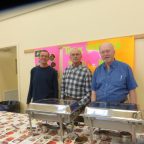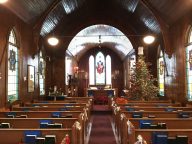April 13, 2017 Column
Finishing the Story of Easter
Rev. Yme Woensdregt
For many people, Easter is a time of chocolates and bunnies, a time to welcome the returning warmth of spring, especially after the winter we’ve had. We feel the warmth of the sun on our skin and our thoughts turn naturally to spring projects. We put away most—but not quite all—of our winter clothing, and we watch with pleasure as the green buds on the trees turn to leaves and flowers begin to spring once again from the earth after its long winter nap.
For the church, Easter is a time to celebrate the resurrection of Jesus. We sing our alleluias and rejoice that “Christ the Lord is risen today.” Easter is a day for joy and celebration and thanksgiving for the renewal of life.
But it was not always so.
It strikes me this year in a new way that the first Easter was marked more by fear and confusion and pain than by joy and celebration. All four gospels in the Bible tell stories about a group of disciples who can’t make sense of what is happening.
There are some common threads in the stories: some of the women who had followed Jesus come to the tomb early Sunday morning after the Sabbath had ended. They discover that the stone sealing the entrance of the tomb has been rolled away and the tomb is empty. They don’t find the body of their friend and teacher. In each story, an angel announces that Jesus has risen.
Beyond those common threads, the stories differ in marked ways.
The last gospel to be written was John. It comes from around 95–105, about 65 years after Jesus’ crucifixion and resurrection. John tells a touching story about Mary’s pain. She weeps outside the tomb, wandering in a daze of confusion. When the risen Jesus stands near her, she doesn’t recognize him—until he calls her by name. Then she runs back to tell the others, “I have seen the Lord.”
Luke and Matthew were written about a decade earlier. In Luke’s story, the angel reminds the women that Jesus had told them he would rise again. “They remembered his words,” ran back and “told all this to the eleven and to all the rest.” The apostles didn’t believe them; “these words seemed to them an idle tale.” You can’t believe the women, after all.
Luke continues with a story of a couple of disciples (probably a husband and wife) who travel home to Emmaus the same day, only to encounter the risen Jesus when he breaks bread with them after they’ve reached home.
Matthew tells a story about an earthquake, which explains how the stone had rolled away from the mouth of the tomb. He mentions that Pilate had posted a guard—a story which was likely told to counter later rumours that the disciples had stolen the body and spread a lie that Jesus had been raised.
I want to focus on Mark’s story. Mark was almost certainly the earliest gospel, written sometime around the year 70.
Mark’s gospel ends very strangely. The women come to the tomb and find it empty. They see “young man dressed in a white robe” who tells them that Jesus has risen. “Hh is going before you to Galilee; there you will see him, as he told you.”
You would think the story would end with the women returning to the disciples to tell this this news. But it doesn’t. The story ends this way: “And they went out and fled from the tomb; for trembling and astonishment had come upon them; and they said nothing to any one, for they were afraid.”
Full stop.
Later copyists thought this was a very strange way to end the story. They might have thought that the ending was lost, or damaged in some way. At least a couple of scribes added their own endings, in which Jesus appeared to the disciples. Modern Bibles include these as a “shorter ending” and a “longer ending.” These endings, however, only appear in very late manuscripts. The earliest manuscripts end with the women being silent and fearful.
I suspect that Mark knew exactly what he was doing, and that he ends the gospel this way deliberately. At the very beginning of his gospel, Mark tells us that his story is “The beginning of the gospel of Jesus Christ.” This whole story is the beginning of the good news. Mark’s open–ended conclusion invites us into the story.
The resurrection of Jesus isn’t a conclusion. It’s an invitation. We are invited to continue the story of what God is doing in the world. The story which Mark begins continues in us, in all the generations who have come after him, in all those people who have been inspired to continue the story of God’s healing love.
The story of Easter life continues in us as we reach out in love and compassion to the world. I wish for you a happy Easter, and many opportunities to be loving and compassionate people.







